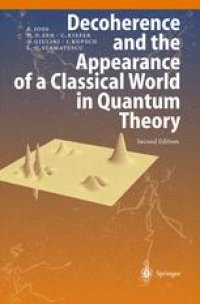
Ebook: Decoherence and the Appearance of a Classical World in Quantum Theory
Author: Erich Joos H. Dieter Zeh Claus Kiefer Domenico Giulini Joachim Kupsch Ion-Olimpiu Stamatescu (auth.)
- Tags: Quantum Physics, Mathematical Methods in Physics, Quantum Information Technology Spintronics
- Year: 2003
- Publisher: Springer-Verlag Berlin Heidelberg
- Edition: 2
- Language: English
- pdf
This book describes the phenomena that arise from the interaction between quantum systems and their environment. Since the first edition appeared in 1996, the concepts of decoherence have become firmly established experimentally and are now widely used in the literature. Its major consequences are the emergence of "classicality", superselection rules, the border line between microscopic and macroscopic behavior, the emergence of classical spacetime, and the appearance of quantum jumps.
Most of the new developments in this rapidly evolving field are discussed in this second edition: chaos theory, quantum information, neuroscience, primordial fluctuations in cosmology, black holes and string theory, experimental tests, and interpretational issues. While the major part of the book is concerned with environmental decoherence derived from a universal Schrödinger equation, later chapters address complementary or competing approaches, such as consistent histories, open system dynamics, algebraic methods, and collapse models.
This book describes the phenomena that arise from the interaction between quantum systems and their environment. Since the first edition appeared in 1996, the concepts of decoherence have become firmly established experimentally and are now widely used in the literature. Its major consequences are the emergence of "classicality", superselection rules, the border line between microscopic and macroscopic behavior, the emergence of classical spacetime, and the appearance of quantum jumps.
Most of the new developments in this rapidly evolving field are discussed in this second edition: chaos theory, quantum information, neuroscience, primordial fluctuations in cosmology, black holes and string theory, experimental tests, and interpretational issues. While the major part of the book is concerned with environmental decoherence derived from a universal Schr?dinger equation, later chapters address complementary or competing approaches, such as consistent histories, open system dynamics, algebraic methods, and collapse models.
This book describes the phenomena that arise from the interaction between quantum systems and their environment. Since the first edition appeared in 1996, the concepts of decoherence have become firmly established experimentally and are now widely used in the literature. Its major consequences are the emergence of "classicality", superselection rules, the border line between microscopic and macroscopic behavior, the emergence of classical spacetime, and the appearance of quantum jumps.
Most of the new developments in this rapidly evolving field are discussed in this second edition: chaos theory, quantum information, neuroscience, primordial fluctuations in cosmology, black holes and string theory, experimental tests, and interpretational issues. While the major part of the book is concerned with environmental decoherence derived from a universal Schr?dinger equation, later chapters address complementary or competing approaches, such as consistent histories, open system dynamics, algebraic methods, and collapse models.
Content:
Front Matter....Pages I-XII
Introduction....Pages 1-5
Basic Concepts and Their Interpretation....Pages 7-40
Decoherence Through Interaction with the Environment....Pages 41-180
Decoherence in Quantum Field Theory and Quantum Gravity....Pages 181-225
Consistent Histories and Decoherence....Pages 227-258
Superselection Rules and Symmetries....Pages 259-315
Open Quantum Systems....Pages 317-356
Stochastic Collapse Models....Pages 357-381
Related Concepts and Methods....Pages 383-393
Equation of Motion of a Mass Point....Pages 395-397
Solutions for the Equation of Motion....Pages 399-406
Elementary Properties of Composite Systems in Quantum Mechanics....Pages 407-414
Quantum Correlations....Pages 415-418
Hamiltonian Formulation of Quantum Mechanics....Pages 419-424
Galilean Symmetry of Non-Relativistic Quantum Mechanics....Pages 425-431
Stochastic Processes....Pages 433-443
Back Matter....Pages 445-500
This book describes the phenomena that arise from the interaction between quantum systems and their environment. Since the first edition appeared in 1996, the concepts of decoherence have become firmly established experimentally and are now widely used in the literature. Its major consequences are the emergence of "classicality", superselection rules, the border line between microscopic and macroscopic behavior, the emergence of classical spacetime, and the appearance of quantum jumps.
Most of the new developments in this rapidly evolving field are discussed in this second edition: chaos theory, quantum information, neuroscience, primordial fluctuations in cosmology, black holes and string theory, experimental tests, and interpretational issues. While the major part of the book is concerned with environmental decoherence derived from a universal Schr?dinger equation, later chapters address complementary or competing approaches, such as consistent histories, open system dynamics, algebraic methods, and collapse models.
Content:
Front Matter....Pages I-XII
Introduction....Pages 1-5
Basic Concepts and Their Interpretation....Pages 7-40
Decoherence Through Interaction with the Environment....Pages 41-180
Decoherence in Quantum Field Theory and Quantum Gravity....Pages 181-225
Consistent Histories and Decoherence....Pages 227-258
Superselection Rules and Symmetries....Pages 259-315
Open Quantum Systems....Pages 317-356
Stochastic Collapse Models....Pages 357-381
Related Concepts and Methods....Pages 383-393
Equation of Motion of a Mass Point....Pages 395-397
Solutions for the Equation of Motion....Pages 399-406
Elementary Properties of Composite Systems in Quantum Mechanics....Pages 407-414
Quantum Correlations....Pages 415-418
Hamiltonian Formulation of Quantum Mechanics....Pages 419-424
Galilean Symmetry of Non-Relativistic Quantum Mechanics....Pages 425-431
Stochastic Processes....Pages 433-443
Back Matter....Pages 445-500
....